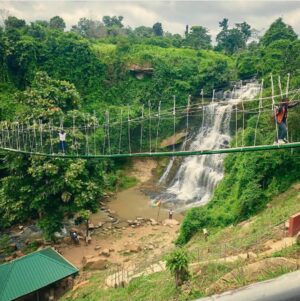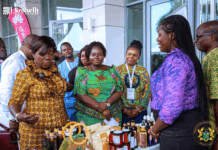…and rapidly transform Ahafo, Bono, Oti & other new regions
TOURISM is a very broad multi-purpose and holistic industry which is founded on natural, man-made, cultural and heritage resources. The industry has emerged stronger and stood-out as the biggest, fastest and largest industry and consolidated its rating as an international and multi-million competitive cash-cow sector in vogue around the world, since the turn of the millennium, until the pandemic devastation and disruption in 2019.
Ghana Our Homeland also has an outstanding national tourism potential and stand peerless with a number of remarkable tourism resources in all the four main broad natural, man-made, cultural and heritage tourism resource classification domains, which is fairly distributed across the length and breathe of the Motherland.
Competitive edge
Political stability, relative national peace, safety and security as well Ghana’s world rated acknowledge warm national hospitality trait are intangible and valueless outstanding national unique tourism-selling points (USPs) that give Our Homeland Ghana national tourism competitive advantages.
Sector Standing
The sector currently ranked as the fourth (4th) largest contributor to gross domestic product behind cocoa, gold and remittances from Ghanaians abroad.
Unharnessed Potential
There are a lot many undocumented rare national tourism resources together with the little developed national tourism potential which supports the strong school of that Ghana’s tourism potential development and current standing the accolade, “ Tourism In Ghana -An Unexplored National Tourism and Unsung National Sacred Cash-Cow” .

Researches unimpressed by sectoral output
Many multiple researches, studies, analysis by public and independent consultants, academia, development consultants, experts and planners, tourism analysts, tourism consultants, experts and researchers have observed that Ghana has many outstanding but undocumented other tourism resources and potentials ,so is the current national tourism industry performance and output is far below the country’s actual capacity.
Ministerial target
Dr. Alhaji Ibrahim Mohammed AWAL assumed with a clear target and commitment to ensure the tourism sector is transformed and repositioned as the number one contributor to gross domestic product (GDP) by 2024.
Decentralize Tourism & Hospitality Legislation
The researches and studies strongly recommended the need to revise, review and amend Ghana’s overall national tourism development strategy and policy (NTDS&P) and also need to enact modern national tourism and hospitality legislation (NT&HL), policy regime (PR), using a very comprehensive decentralized national tourism development strategy approach.
MMDAs & TARs
The studies and researches recommended that the proposed new NT&HLs and policy regime must promote comprehensive decentralized national tourism development strategy with Metropolitan, Municipal and District Assembles (MMDAs) and traditional authorities and rulers (TARS) as strategy and key frontline tourism custodians, practitioners and players.
Way Forward
The tourism industry and development has become an international competitive cash-cow and stands out as the biggest, fastest and the largest emerging industry in the world, since the turn of the millennium consistently over the past nineteen (19) years until the debilitating and devastating corona virus (covid-19) pandemic in late 2019, to rustle and scuttle an otherwise burgeoning international industry.
It was an international multi-million dollar strategic socio-economic transformative and development catalyst, which has transformed and repositioned many economies across the developing and developed divides.
New Regions
The main objective for the creation of Ahafo (A/R), Bono (B/R), Bono-East (BE/R), Nort- East ( NE/R), Savannah (S/R), Oti (O/R) and Western-North (WN/R) regions was lack of development and need to bridge the developmental gap between the new regions and the older regions.

Tourism as an outstanding biggest, fastest and largest growing industry in vogue around the world, a deliberate national policy strategy to prioritize development with the creation well-resourced tourism regional offices for the six (6) new political administrative regions, would go a long way to effortlessly achieve the object for the creation of the regions.
…Focus on Ahafo, Bono & Bono East Regions
THE Ahafo Region (A/R), Bono, (B/R), and Bono-East (BE/R) regions at Goaso, Sunyani and Techiman respectively together with the other new regions of North-East (NE/R), Savannah (S/R) and Western-North (WN/R) are without doubt and contradiction classified as Ghana’s rare but undocumented, neglected and relegated tourism treasures, overflowing with several rare but unknown tourism resources and potential.
The six (6) new regions can stand tall and deserving as virgin tourism treasures that must be prioritized and harnessed for rapid socio-economic transformation of these region, to bridge the development gap and eventually bring the new regions at par with the ten old regions.

Resources
Among outstanding tourism resources and facilities which are in the three regions include the evergreen Kintampo Waterfalls at Kintampo, Buabeng-Fiema Monkey Sanctuary, at Busua-Nkroranza, Buoyem Caves and Bat Colony, Buoyem, all in the Bono East Region. Others are the Duasidan Monkey Sanctuary, Tano Boase Sacred Grove, Fuller Waterfalls at Yabraso, the Bui National Park in the Tain District, the Digya National Park at Sene-Digya, the Bono Manso Slavery Centre and the Hani Archaeological Site at Hani among others.
Hospitality facilities
A number of star rated hospitality- accommodation and catering facilities in located in the regions to catering for the accommodation, catering and entertainment needs of the growing tourists and visitors into the infant regions and beyond. Notable among them include Berlin, Masco Foods Limited, Mandela, RoyalsJ., Sweet Touch, Jakosa Gardens and Elkems Tasty Restaurants. Others are Eusbett, Chesvile,Glammossay, Tyco, Aboaah, Henpom, Regent Resorts and Sheila’s Executive Lodge hotels and others are located in Sunyani of the Bono Region. The Ahafo Region (A/R) at Goaso on the other hand has Astom Hotel Annex,Zeniel Oasis, Frienship, King Kharma, Petlinda Executive and Wadada & Sons facilities. Whilst in the Bono East Region is found De Georgio Hotel ,Akina City Restaurant, Villakam Hotel, Micas Hotel ,
Nat Vision Hotel, Encom, Agyeiwaa, Premier Palace and Thomelia facilities abound. Falls Palace, Noble,Adoma Momorial,Hotel De Baps, Royal Unity and among others are hospitality facilities found the three sister new regions.
National Tourism Legislation
The Ministry of Tourism, Arts and Culture need to prioritize and rally its agencies, collaborating stakeholders and partners to expend part of its energies, resources also a fraction of IDA Tourism Grant to enact a national tourism legislation (NTL) for the country.
Thematic areas
The proposed national tourism legislation must broad-based and comprehensive including;
Assemblies & TAR as Statutory Tourism Custodians
Metropolitan, Municipal and District Assemblies (MMDAs) and Traditional Authorities and Rulers (TARs) as statutory and strategic tourism custodians (S&STCs) with an attractive tourism revenue sharing formula (TRSF), would promote inclusive and holistic national tourism potential development across the country, which would in turn promote a very balance national tourism traffic distribution, reduce congestion at plants and destinations, and above all serve a remote strategy for an all year round vibrant , robust , sustainable , attractive and competitive model domestic and national tourism industry and eventually become a United National World Tourism Organization (UNWTO) certified centre of excellence in tourism development , model and case study.
Model Destinations and district destinations
The infant public tourism sector among others has low and poor national budgetary allocation is one key challenges which is not adequate enough for administrative and consumable overheads to think of capital tourism investments and projects, the Ministry of Tourism, Arts and Culture (MOTAC) must therefore devise a smart strategy to decouple itself from capital intensive projects but instead transform itself into technical savvy constancy ministry and also adopt tourism development proactive Metropolitan, Municipal and District Assemblies (MMDAs), notable among Ada East District, Afadzato South District,Anloga District , Hohoe Municipal Assembly, kwahu South Municipal Assembly, Komenda-Edina-Eguafo-Abirem Municipal and Sekyere-Kumawu District Assemblies and others and designate these assemblies as national model tourism destinations (NMTDs) with well and clearly defined motivative tourism revenue sharing formula , to whip, entice, and encourage each and every assembly to prioritize and embrace tourism development and promotion.

MOTAC also take steps to technically support all assemblies to identify their individual tourism strengths, which properly branded autonomous destinations to promote a very vibrant, robust and an all year-round district, regional and national tourism industry.
Know the Creative Arts Agency Act 2020, Act1048… (1)
The Creative Arts Agency, its Governing Board, Mandate, Object and Administration, the Creative Arts Industry Fund, its Object, Sources of Funding, Management and Eligibility & Regulation
THE One Thousand and Forty-Eighth (1048th) legislation by the Sovereign Parliament of the Republic of Ghana is dubbed the Creative Arts Industry Act 2020. It is a Seventeen (17)-page, thirty-three (33)-sectioned legislative enactment (LE) that seek to, “establish a Creative Arts Agency”.
The enactment received Presidential Assent /Seal (PA/S) on 29th December, 2020, to become a binding and applicable national law.
The new Law (L), in section one (1), paragraph one (1) effectively and legally created and established the Creative Arts Agency (CAA) , as a statutory body corporate, to , “provide the institutional framework for the development and management of the creative arts industry and for related matters” in Ghana.
Governance / Governing Body
The Enactment in Section (4) subsection (1) provided for and created a Fourteen (14)-Member Governing Body for CAA and chaired by a nominee of the Minister of Tourism, Arts and Culture (MOTAC), with the competence and experience in the Creative Arts Industry (CAI).
Membership & tenure
Membership of CAA Governing Body include the Executive Secretary (ES)/ the Chief Executive Officer (CEO) of the Creative Arts Agency, who also doubled as the Secretary to the CAA Governing Body.
Membership
Membership of the CAA Governing Body include Seven (7)-representatives from the creative arts industry domain at least three (3) of whom are women nominated by the creative arts industry to represent the domain on rotational basis and the Copyright Administrator (CA).Others are a representative each of Ministry responsible for Tourism, Arts and Culture (MOTAC), Trade and Industry (MOTI), Finance (MOF) as well as a rep from the Office of the Attorney-General, (MOJ&AG) whilst the tenure of members of the board has a duration of four (4) years and a member is eligible for reappointment for another term only.
Executive Secretary & her/his functions
The Law in Section twelve (12) created the position and office of Executive Secretary (ES), for the Agency, who is appointed by the President in accordance with article 195, with regard to relevant qualifications, experiences and knowledge of that person in the creative arts industry (CAI) and business orientation and proven experience of that person in managing and motivating multi-disciplinary teams of professionals.
The Executive Secretary (ES) for the Creative Arts Agency (CAA), according to Section thirteen) (13), of the law is responsible for the day-to-day administration of the Agency and is answerable to the Agency’s Governing Board in the performance of functions under Act 1048, ES also double as the Secretary to the Agency’s Board, who shall perform any other functions determined by the Board.
Objects of CAA
The Law in Section two (2) listed five (5) key objects of the CAA among which are to prescribe standards for the regulation of the creative arts industry, create an enabling environment through direct and indirect support for arts education, artistes, creative arts practitioners and organizations, promote collaborations with institutions created for the regulation of the specific domains in the creative arts industry, artistes and creative arts practitioners, and organizations, nationally and internationally, grow the creative arts industry nationally and internationally through partnership and industry development assistance that facilitates pathways to organization and innovation and also ensure that access to the market by creative arts practitioners is enhanced.
Functions
Section three (3) of the Law, 1048, 2020 mandates the Creative Arts Agency (CAA) to ensure the effective organization and management of the creative arts industry, foster an enabling environment for industry-Jed approaches to boost the growth and competitiveness of the creative arts industry, advise the Minister on matters relating to standards for the regulation of the creative arts industry, facilitate the engagement of the creative arts industry players by providing a forum for meeting with the creative arts industry operators, encourage public and private sector interface and alignment by providing a forum for creative arts industry practitioners to meet with relevant public sector organizations and agencies, promote new trends in the creative arts industry in relation to the organization and management of creative enterprises, oversee cross-sector challenges as they affect the creative arts industry and manage the challenges. Other mandates of the CAA to the organization and management of creative arts enterprises.
Act 817, GTA @10 & Matters Arising… (1)
LEGISLATIONS and legal regime (LLRs) are crucial intangible and soft resources and assets that propel the growth, development and evolution of professions and vocations including tourism in the world.
The Tourism Act 2011, Act 817 is the legislation on our statues as the current national legislation (NTL) that is applicable and which sets the parameters for the conduct of including regulation, control and promotion of tourism business, in Ghana’s burgeoning, evergreen and infant tourism industry and its related matters in the Ghanaian jurisdiction.
Background
Act 817 was enacted some ten (10) years ago, where it went through the rigorous procedures, processes and demands in law and procedures in legislation enactment (LE) and parliamentary ,procedures, processes, with its associated delays and challenges to be enacted , which eventually received Presidential Seal, as a full-fledged and binding national law on our statues on 16th May, 2011.
Ghana Tourism Authority
The Act 817 Law, is a twenty (20)-page, fifty-one (51)-sectioned piece of legislation, which in Section one (1) provided and created the Ghana Tourism Authority (GTA), a body corporate, as the statutory national tourism regulator, the authority is thus the main and lead national tourism frontline implementing agency of the Ministry of Tourism, Arts and Culture (MOTAC).
Governing body
The Law in section four (4) provided and created an 11-Member Governing Body for the GTA, as a body corporate, consisting of representatives from the private sector, which chairs the Board and others from the Ministry of Tourism, Arts and Culture (MOTAC), GTA’s Chief Executive Officer (CEO), ministries of finance and economic planning (MOFEP),local government , rural development and decentralization (MOLGR&D),lands and natural resources (MOLNR),chieftaincy and religious affairs (MOC&RA) and environment, science ,technology and innovation (MOESTI).
Object of GTA
The Law, Act 817, in Section two (2) on the other hand stated as the object of the GTA as,”to promote the sustainable development of the tourism industry internationally and within the country”.
Mandate & functions
Additionally, Section three (3) of Act 817,2011, which created the Ghana Tourism Authority (GTA),as the statutory national tourism regulator (NTR) gave the GTA a sixteen-point mandate and or guideline and tasks, to implement to attain its objectives, among include to implement and ensure compliance to regulations developed in accordance with the Act, grant licences for the tourism industry, regulate and supervise tourism enterprises, as well as regulate and monitor the activities of licensees. The law mandates GTA to initiate, conduct, promote and encourage studies for the growth and development of the tourism industry.
Additionally, the law tasked the Authority to ensure pro-poor, sustainable and responsible tourism development in the country. It further imposed on GTA the responsibility to develop standards and guidelines for designs for use at tourist attractions and enterprises to reflect Ghanaian culture.
The need to take appropriate measures for the safety and security of consumers of the tourism industry is also the mandate of the Authority.
Others
Other GTA’s responsibilities imposed on GTA as provided by Act 817 are include to identify and acquire suitable land for tourism development as well as perform any other functions incidental or conducive to the attainment of the object of the Authority as frontline and key responsibilities that the Tourism Act imposed on the Authority, collection, compilation and publication of information and statistics in respect of activities regulated under this act as well as advise the Minister of Tourism on policy issues generally on matters related to the tourism industry are other demands that the law imposed on the Ghana Tourism Authority.
Background
The Tourism Act effectively created the GTA as the statutory national tourism regulator, Act 817 repealed SMCD 80, 1977, which created the Ghana Tourist Board (GTB), GTA’s predecessor.
Regional & District Offices
Sections fifteen (15) and sixteen (16) of the law provided and created GTA regional (GTAROs) and district (GTADOs) offices of the Authority respectively, who perform functions determined by the GTA Board. Tourism Public –Private Partnership Forum
Section Forty-Two (42) of the Tourism Act 2011, Act 817 vividly captures the importance of the tourism private sector and effectively provided thus,” there shall be a Public-Private Partnership Forum (PPPF), to encourage public-private partnerships, to promote tourism development opportunities, the Forum shall be organized by the Ministry in collaboration with the GTA and the private sector.”
The tourism sector has an effective private sector which is organized under the banner of the Ghana Tourism Federation (GHATOF), as the national trade association of all tourism practitioner trade associations in the country, including Ghana Hotels Association, (GHA), Tour Operators Union of Ghana, (TOUGHA), Car Rentals Association of Ghana, (CRAG) and Tour Guides Association of Ghana (TOGAG).
President
Mrs. Bella Ayaye Ahu, a decorated seasoned caterer, Chief Executive Officer (CEO), Traffix Catering Services Limited and towering tourism practitioner is the current president of GHATOF.
Tourism Development Fund
The Tourism Act 2011, Act 817 in section Twenty-One (21) created the Tourism Development Fund (TDF), stating the object of TDF as to provide funding for tourism and tourism related projects and programmes.
The law said further, to achieve the object of the Fund, monies from the Fund shall be applied for relevant tourism activities as the GTA Board may determine including in particular marketing and promotion of tourism, capacity building, market research and development of tourism infrastructure, development and promotion of other entrepreneurial activities, tourism export trade-oriented activities of institutions and tourism education and training.
The Writer is Tourism, Brands, Branding, Communication & Marketing Practitioner, Analyst, Advocate & Activist.









